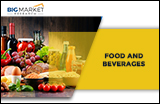
Food Processing Industry in India 2017
- NET3245825
- 62 Pages
- April 2017
- Food and Beverages
A major problem being faced by the industry is the gaps in the supply chain. The country lacks proper storage and distribution facilities. Moreover, the inadequate and high cost of credit is one of the major reasons for the subdued growth of the agricultural sector, the key raw material supplying industry. However, the Government of India has been playing a proactive role in developing the sector and reducing infrastructural hurdles. Through the Ministry of Food Processing Industries (MoFPI), it is providing ample support to the industry. In the Union Budget 2015-16, the government allocated INR ~3.29 bn for infrastructural development. Also, the National Mission on Food Processing, a centrally sponsored scheme launched by MoFPI, is promoting the development of facilities for post-harvest operations in the country. India already has 14 mega food parks, and an additional eight food parks are expected to be operational by the end of this year. This will further aid in the development of the country's food processing industry.
Coverage:
Overview of the Food Processing Industry, and historical and forecasted market size data over FY 2012 to FY 2020
Trade analysis of processed food in India
Qualitative analysis of the major drivers and challenges affecting the market
Analysis of the competitive landscape and profiles of major public and private players operating in the market
Key recent developments in the Indian food processing industry
Why Buy?
Get a broad understanding of the food processing industry in India, the dynamics of the market and the current state of the industry
Devise market-entry strategies by understanding the factors driving the growth of the market
Identify key growth opportunities in the industry and make informed decisions to increase profitability
Understand major competitors' business and market dynamics, and respond accordingly
Socioeconomic Indicators
Slide 2: Total Population (2010-2011 – 2019-2020), Population Density (2010-2011 – 2019-2020)
Slide 3: Sex Ratio (2005, 2010, 2015, 2020), Population by Age Group (2005, 2010, 2015, 2020), Urbanization Trend (2010-2011 – 2019-2020)
Slide 4: Total Fertility Rate (2005-2010, 2010-2015, 2015-2020), Infant Mortality Rate (2005-2010, 2010-2015, 2015-2020), Total Number of Births (2005-2010, 2010-2015, 2015-2020), Total Number of Death (2005-2010, 2010-2015, 2015-2020)
Slide 5: Total Literacy Rate (2001, 2011), Rural Literacy (2001, 2011), Urban Literacy (2001, 2011)
Slide 6: GDP at Market Prices (2010-2014), FDI (2010-2014), Inflation Rate (2010-2014), Unemployment Rate (2010-2014)
Slide 7: Access to Safe Drinking Water (2001, 2011), Exchange Rate (2010-2015)
Market Overview
Slide 8: Market Definition & Structure
Slide 9: Agricultural Export Zones in India
Slide 10: Market Characteristics and Value Chain
Slide 11: Food Processing Industry in India – Market Overview, Size and Growth (FY 2012 – FY 2020e)
Slide 12-13: Food Processing Industry in India – Market Segmentation
Slide 14: Investments in Food Processing and Agriculture Industry
Slide 15: Porter’s Five Forces Analysis
Trade Analysis
Slide 16: Export of Preparations of Cereals, Flour, Starch or Milk – Size (Value-Wise; FY 2013 – FY 2017(Apr-Nov)) and Country-Wise Segmentation (Value-Wise; FY 2015 and FY 2016)
Slide 17: Import of Preparations of Cereals, Flour, Starch or Milk – Size (Value-Wise; FY 2013 – FY 2017(Apr-Nov)) and Country-Wise Segmentation (Value-Wise; FY 2015 and FY 2016)
Slide 18: Export of Preparations of Vegetables, Fruits, Nuts or Other Plant Parts – Size (Value-Wise; FY 2013 – FY 2017(Apr-Nov)) and Country-Wise Segmentation (Value-Wise; FY 2015 and FY 2016)
Slide 19: Import of Preparations of Vegetables, Fruits, Nuts or Other Plant Parts – Size (Value-Wise; FY 2013 – FY 2017(Apr-Nov)) and Country-Wise Segmentation (Value-Wise; FY 2015 and FY 2016)
Slide 20: Export of Miscellaneous Edible Preparations – Size (Value-Wise; FY 2013 – FY 2017(Apr-Nov)) and Country-Wise Segmentation (Value-Wise; FY 2015 and FY 2016)
Slide 21: Import of Miscellaneous Edible Preparations – Size (Value-Wise; FY 2013 – FY 2017(Apr-Nov)) and Country-Wise Segmentation (Value-Wise; FY 2015 and FY 2016)
Slide 22: Export of Processed Food – Size (Value-Wise; FY 2013 – FY 2017(Apr-Nov)) and Country-Wise Segmentation (Value-Wise; FY 2015 and FY 2016)
Slide 23: Import of Processed Food – Size (Value-Wise; FY 2013 – FY 2017(Apr-Nov)) and Country-Wise Segmentation (Value-Wise; FY 2015 and FY 2016)
Market Influencers
Slide 24-25: Market Drivers
Slide 26: Market Challenges
Competitive Landscape
Slide 27: List of Major Players
Slide 28-58: Profiles of Major Players
Recent Developments
Slide 59-61: Key Strategic Recommendations
Appendix
Slide 62: Research Methodology
Similar Reports
Driven by improving living standards of people and a fast-growing macro-economy, China has remained the largest beer-consuming country worldwide for the 12th consecutive year since 2003, and the largest beer-producing nation globally in the past years. This report focuses on systematic evaluation and analysis of Internal Risks (arising within the industry development itself) and External Risks (ar...
- Publish Date: November 26, 2014
- $800
Summary Based on products type, the report describes major products type share of regional market. Products mentioned as follows: By Type Microparticulated Protein Modified Whey Protein Concentrate Others Based on region, the report describes major regions market by vendor, products and application. Regions mentioned as follows: North America Europe Asia RoW Based on application, the repor...
- Publish Date: March 1, 2017
- $840
Summary The global Oat Protein market is estimated to reach 1.4 K MT in 2017. The objective of report is to define, segment, and project the market on the basis of type, application, and region, and to describe the content about the factors influencing market dynamics, policy, economic, technology and market entry etc. Based on products type, the report describes major products type share of regio...
- Publish Date: April 15, 2017
- $840